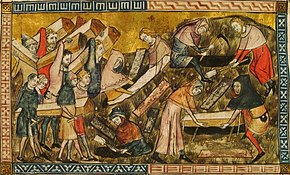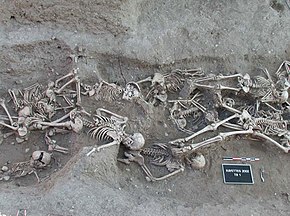History
Yersinia pestis has been discovered in archaeological finds from the Late Bronze Age (~3800 BP).[37] The bacteria is identified by ancient DNA in human teeth from Asia and Europe dating from 2,800 to 5,000 years ago.[38]
First pandemic
The first recorded epidemic affected the Sassanian Empire and their arch-rivals, the Eastern Roman Empire (Byzantine Empire) and was named the Plague of Justinian after emperor Justinian I, who was infected but survived through extensive treatment.[39][40] The pandemic resulted in the deaths of an estimated 25 million (6th century outbreak) to 50 million people (two centuries of recurrence).[41][42] The historian Procopius wrote, in Volume II of History of the Wars, of his personal encounter with the plague and the effect it had on the rising empire. In the spring of 542, the plague arrived in Constantinople, working its way from port city to port city and spreading around the Mediterranean Sea, later migrating inland eastward into Asia Minor and west into Greece and Italy. The Plague of Justinian is said to have been "completed" in the middle of the 8th century.[14] Because the infectious disease spread inland by the transferring of merchandise through Justinian's efforts in acquiring luxurious goods of the time and exporting supplies, his capital became the leading exporter of the bubonic plague. Procopius, in his work Secret History, declared that Justinian was a demon of an emperor who either created the plague himself or was being punished for his sinfulness.[42]
Second pandemic
In the Late Middle Ages Europe experienced the deadliest disease outbreak in history when the Black Death, the infamous pandemic of bubonic plague, hit in 1347, killing one-third of the European human population. Some historians believe that society subsequently became more violent as the mass mortality rate cheapened life and thus increased warfare, crime, popular revolt, waves of flagellants, and persecution.[43] The Black Death originated in Central Asia and spread from Italy and then throughout other European countries. Arab historians Ibn Al-Wardni and Almaqrizi believed the Black Death originated in Mongolia. Chinese records also showed a huge outbreak in Mongolia in the early 1330s.[44]
Research published in 2002 suggests that it began in early 1346 in the steppe region, where a plague reservoir stretches from the northwestern shore of the Caspian Sea into southern Russia. The Mongols had cut off the trade route, the Silk Road between China and Europe, which halted the spread of the Black Death from eastern Russia to Western Europe. The epidemic began with an attack that Mongols launched on the Italian merchants' last trading station in the region, Caffa in the Crimea.[27]
In late 1346, plague broke out among the besiegers and from them penetrated the town. The Mongol forces catapulted plague-infested corpses into Caffa as a form of attack, one of the first known instances of biological warfare.[45] When spring arrived, the Italian merchants fled on their ships, unknowingly carrying the Black Death. Carried by the fleas on rats, the plague initially spread to humans near the Black Sea and then outwards to the rest of Europe as a result of people fleeing from one area to another. Rats migrated with humans, traveling among grain bags, clothing, ships, wagons, and grain husks.[18] Continued research indicates that black rats, those that primarily transmitted the disease, prefer grain as a primary meal.[14] Due to this, the major bulk grain fleets that transported major city's food shipments from Africa and Alexandria to the heavily populated areas, and then unloaded by hand, played a role in the transmission effectiveness of the plague.[14]
Third pandemic
The plague resurfaced for a third time in the mid-19th century. Like the two previous outbreaks, this one also originated in Eastern Asia, most likely in Yunnan, a province of China, where there are several natural plague foci.[46] The initial outbreaks occurred in the second half of the 18th century.[47][48] The disease remained localized in Southwest China for several years before spreading. In the city of Canton, beginning in January 1894, the disease killed 80,000 people by June. Daily water-traffic with the nearby city of Hong Kong rapidly spread the plague there, killing over 2,400 within two months during the 1894 Hong Kong plague.[49]
Also known as the modern pandemic, the third pandemic spread the disease to port cities throughout the world in the second half of the 19th century and the early 20th century via shipping routes.[50] The plague infected people in Chinatown in San Francisco from 1900 to 1904,[51] and in the nearby locales of Oakland and the East Bay again from 1907 to 1909.[52] During the outbreak from 1900 to 1904 in San Francisco is when authorities made permanent the Chinese Exclusion Act. This law was originally signed into existence by President Chester A. Arthur in 1882. The Chinese Exclusion Act was supposed to last for 10 years, but was renewed in 1892 with the Geary Act and subsequently made permanent in 1902 during the outbreak of plague in Chinatown, San Francisco. The last major outbreak in the United States occurred in Los Angeles in 1924,[53] though the disease is still present in wild rodents, and can be passed to humans that come in contact with them.[54] According to the World Health Organization, the pandemic was considered active until 1959, when worldwide casualties dropped to 200 per year. In 1994, a plague outbreak in five Indian states caused an estimated 700 infections (including 52 deaths) and triggered a large migration of Indians within India as they tried to avoid the plague.[citatio


